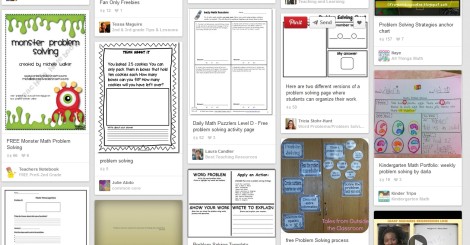This article is part of the 31 Days of Pinterest Hacks series. Find the main page for this series here.
We encounter and solve problems daily—several times a day. Children are provided with fabricated scenarios to solve in school, yet life is full of problems!
You will be able to find plenty of worksheets on Pinterest with the promise of helping a child learn to solve problems accurately. However, some children may find word problems quite baffling since they involve using numbers, operations, and words. These three elements are enormous tasks that no pretty worksheet can solve.
This post gives you four essential tips to help a neurodivergent or disabled child become a better problem solver.

Problem-solving worksheets found on Pinterest. Don’t be fooled by them. Children use higher-level thinking skills as they solve real-life problems daily.
Why problem-solving may be a challenge for neurodivergent and disabled children
- To solve word problems, children must have strong reading comprehension skills, which can be challenging for children with learning disabilities.
- Children with attention difficulties may lose focus as they read through a word problem.
- Some children may not be reading yet.
Suggestions for problem-solving
- Encourage the child to solve life’s problems. As an adult working with a neurodivergent or disabled child, you may be inclined to do things for the child. Seeing them struggle is hard, and your first inclination is to reach out and solve the problem for them. Problem-solving begins before the child is school-aged and expected to sit and think through make-believe problems.
In play alone, children are constantly asked to solve a problem. Does that shape fit into that hole? Why doesn’t this ball fit into that basket as easily as the smaller one? How do I get this doll to cry? Children have many difficulties to sift through in one day, and these experiences help them build a stronger sense of the world and a stronger ability to solve problems.
Some of my son’s everyday problems include figuring out how to back up his legs so that he can shut the door properly, how to shift his body weight so that he can turn the walker in the direction he wants it to go, and how to position his fingers so that he can flip the pages of the book. None of these involve numbers, but each is a significant problem-solving skill. I’m tempted often to move the walker or flip the pages myself. With my teacher hat on, I know I need to back off, give him time, and let him do his thing.
Become conscious of where you’re interfering, take a step back, and watch the child figure it out on their own.
- Provide mathematical scenarios for the child to solve. Throughout your day, draw attention to math-related problems the child can solve. For example, while counting the number of napkins needed to set the table, ask how many more they would need if we invited their cousin to dinner. Two cousins? Incorporate problem-solving while coloring, while painting, while outdoors, etc. Don’t leave a stone unturned, as there are opportunities for number-related problems for the child to solve in everything they do.
- Children do not need to know basic facts before tackling a problem. Since problems are everywhere for children to unravel, there is no need to worry about memorizing basic facts or even being able to write numbers. Children learn to solve problems by solving problems.
- Provide real–life manipulatives. There is no need to purchase counting rods (although you can) to have a child engage in problem-solving. Use the tools they need to solve that exact problem. If they’re dividing a set of stones at the park, the stones are the manipulatives. If they’re counting napkins, those are their manipulatives.
Give children the time they need to explore and learn. Allow life’s problems to be solved as they arise. When the child is ready, begin teaching the symbolic equations that go along with the problems the child is solving.
Since the difficulty levels with problem-solving are vast, it’s impossible for me to write about them in one article. If you’d like more personalized strategies geared to a child you support, I’d love to help you.
Resource
- Adapting Board Games for Neurodivergent and Disabled Learners – Board games make for great problem-solving practice.

0 Comments